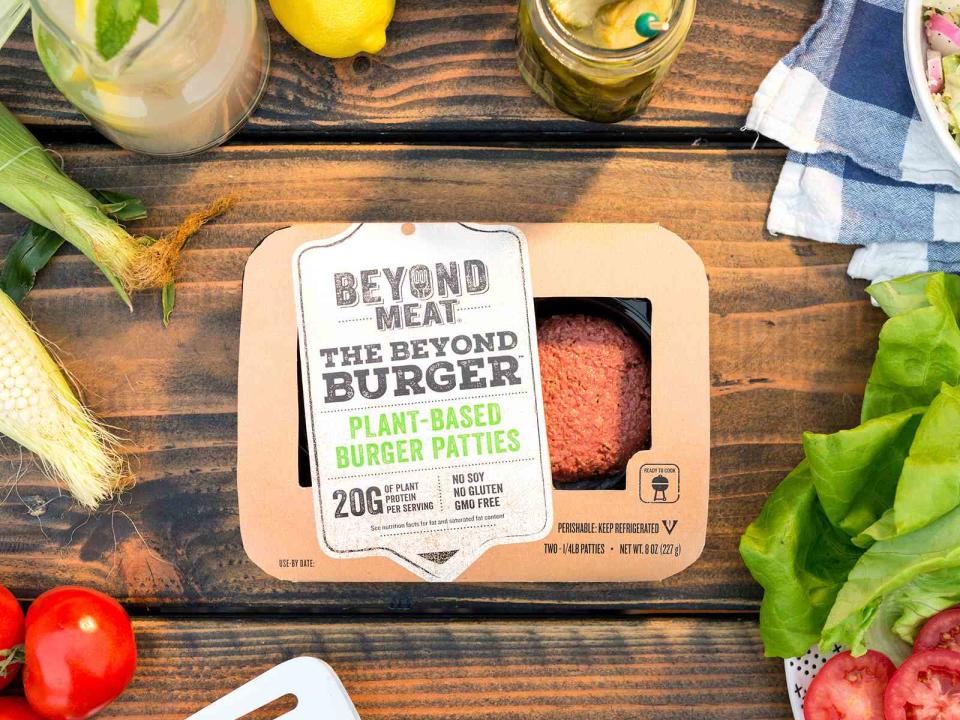What Is Plant-Based Meat? Here's What You Should Know
It can fool even the meat lovers.

Plant-based meat alternatives have come a long way from the Tofurky of yesteryear. From brands like Beyond Meat to Impossible, plant-based meat resembles meat in taste and texture more than ever before. It's also everywhere. Burger King now offers an Impossible Whopper while KFC sells Beyond Chicken nuggets, and Taco Bell has developed a proprietary plant-based meat for its menu. A welcomed option for vegans and vegetarians, plant-based meats are also increasingly popular with omnivores looking to cut back on meat for health and environmental reasons. If you've been curious about all the plant-based meat alternatives hitting the grocery store shelves, let us break down how these products are made and the best ways to use them.
What's Plant-Based Meat Made Of?
While plant-based meats can seem like some convoluted lab experiment, they're mostly made from plants that already regularly appear in our diets. It depends on the brand, but most plant-based meats are made from pea or soy protein, a type of fat, and some sort of binder, but they may also contain natural and artificial flavors to make the product taste more like meat.
Beyond Meat, one widely available plant-based meat alternative, is made from pea, mung bean, fava bean, and brown rice proteins. Whipped coconut oil and cocoa butter form the tiny white pearls that marble their signature 'burgers.' They also add minerals like calcium and iron, and use beet juice and apple extracts for natural coloring and flavor.
Impossible, another popular plant-based meat brand, attributes their products' meaty flavor and texture to heme, a molecule found in hemoglobin proteins that naturally occurs in every plant and animal. That may sound like science fiction to you, but it's essentially just a part of soybean plants Impossible uses to make the product taste like real meat, stay juicy, and appear slightly red at the center.
Other plant-based meat products use ingredients like 'vital wheat gluten,' also known as seitan, a protein derived from wheat to create a meat-like alternative.
Does Plant-Based Meat Really Taste Like Meat?
Plant-based meats, especially burgers, are a fairly convincing animal protein substitute. It certainly can vary from brand to brand, but when it comes to the most ubiquitous meat alternatives on the market, frequently found right next to meat in the case at the grocery store, the taste is on point.
The typical complaint about plant-based meats is that they tend to be drier than the real deal, but it's not uncommon for these meat alternatives to fool meat lovers. Visually, it can be hard to differentiate them from meat, as they brown and char similarly. While some vegans and vegetarians prefer to consume less processed alternatives to meat, such as tofu, others find the similar texture and taste to real meat to be a helpful way to incorporate protein into their diets without consuming animals.
How To Cook With Plant Based Meat
Plant-based meat alternatives come in all forms, from sausages to meatballs. A great place to start with plant-based meat is with the burgers, which fry up just like a regular patty. You can even throw them on the grill. Ground plant-based meat is also easy to incorporate into sauces, casseroles, and stews, just as you would ground beef.
Since plant-based meat tends to already be drier than real meat, be careful not to overcook it, especially when consuming it as a burger. That said, if plant-based meat is undercooked it can be a little mushy, so aim for medium-rare to medium when cooking.
You can season plant-based meat as you would any animal protein, unless you purchase pre-seasoned varieties that already contain added salt and flavors. You'll notice the texture of plant-based meat is stickier than animal proteins, so make sure to use plenty of oil when cooking with it and grease the grates well, if grilling.
How To Store Plant-Based Meat
Unlike beef, chicken, or pork, it's generally not recommended to freeze plant-based meat. That's because it's shipped to stores frozen, then thawed and stored in the fresh meat section. If you purchase it frozen, you can then transfer it to your home freezer and store it for up to three months. According to Beyond Meat, you can store its products in the fridge unopened for up to 10 days after thawing, which grocery stores will indicate with a best by date on the package. Once home, use the product within three days of opening.
Recipes To Try Out With Plant-Based Meat
Here are a few great recipes to incorporate plant-based meat into if you are looking for inspiration. It's a one for one swap with animal proteins and can be cooked and seasoned the same way.
Cast-Iron Skillet Burgers. Swap out the ground beef with a plant-based alternative, for a vegetarian-friendly classic burger.
Greek Stuffed Peppers. Give plant-based meat a taste of the Mediterranean with fresh oregano and feta, for meatless stuffed peppers.
Extra Easy Lasagna. Our easiest lasagna recipe is a great place to swap in plant-based meat for ground beef.
For more Southern Living news, make sure to sign up for our newsletter!
Read the original article on Southern Living.

